Ballistic Edge Triple Torch Model 350 Annealer Review
By Jerry Teo
In the constant quest to improve accuracy and consistency, precision reloaders go to great lengths to prepare their ammo as best they can. The goal is to produce ammo that is as near identical from case to case as humanly possible.
An area that is getting more attention is case neck annealing.
Annealing is simply the process of rapidly heating the case neck to approx 750F for a second or two. This causes the brass to soften and return to a state similar to factory fresh.
Why is this necessary? As brass is fired and sized, it is worked hardened changing its ductility. Over time, this can change the neck tension which can affect your load tuning. If left unchecked, the necks will eventually become brittle and split, ruining the entire case. With expensive or hard to form cases, extending case life is a very good thing.
There have been many methods used over the years with differing amounts of success. The common failure of these methods is in using an arbitrary reference to determine the temperature reached. Because of this variability, annealing has likely done more harm than good, making brass of inconsistent temper, or worse making necks that were too soft.
How to monitor neck temperature
An annealing device must do these things:
1) Position the heat source (usually propane torches with fine tip nozzles) to heat the neck of the case. This should be easily adjustable and secure so that the heat source doesn't move during the run.
2) Position the case in the same location in that flame.
3) Expose the case to the heat source for a precise and repeatable amount of time.
4) Insulate the lower portion of the case so its temperature doesn't exceed 450F. This is absolutely critical for safety as any softening of the case web can cause it to fail.
The subject of this review is the Triple Torch Model 350 Annealer (M350) by Ballistic Edge MFG, which has really impressed me as a tool to get this tricky job done correctly, quickly and in large volumes.
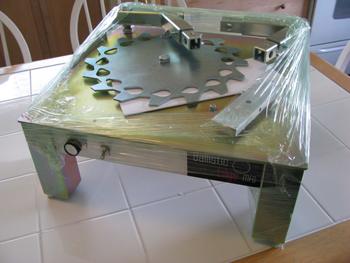
The first impression when I opened the box was WOW, this is a really well made and finished product. Mild steel with a very attractive zinc coating (making it rust resistant) is used throughout. Mine is a yellow/golden. A clear version, which leaves the surface silver is also available. I really like the looks of the finish.
All the welds are expertly done and the annealer is solidly built. There is no way you are going to wear the metal parts out under normal use.
Each leg has a large bolt for leveling, which I didn't need to use as it sat level on my table. You can also view the electronics and drive system.
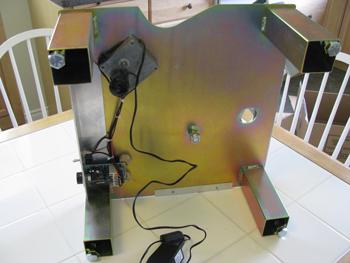
The turntable is really nicely cut out with no sharp or ragged edges. A smart design that accepts all commonly used rifle cases.
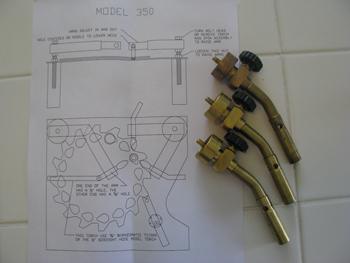
With the instructions is a wonderful CAD drawing which pretty much explains it all in a detailed image. Yes, I read the instructions later but the drawing told me pretty much everything I needed to know. Nice touch.
The annealer comes with the ability to mount 3 propane torches, which is unique. Most will only use two for small and standard sized cases, but if you are annealing the big cartridges like the Chey Tac and BMG, that third torch is going to come in real handy.
The only thing to watch with the propane torch is the size of the nozzle you are using. The holes in the support arm are quite small and the nozzles I had didn't work. The manufacturer supplied some smaller ones, and these fit fine. These were not a common item in my area but may be in others. The tubing used for the arms will not allow you to open up the holes to fit the larger nozzles. Maybe larger tubing can be offered to those that have larger nozzles?
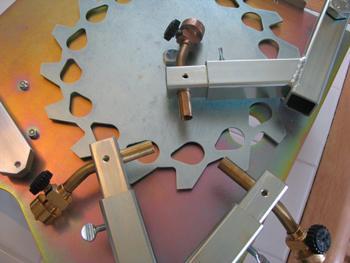
The torches can be arranged so that each flame is 120 degrees apart if using three, or 180 degrees apart if using two. And they can be lowered to work with the 223 or raised to work with the BMG.
Height adjustment is done by moving some jam nuts on a large bolt. I found turning the torch arm made this a bit easier, but required removing the torches first. This is not as simple as a tube in a tube held in place by a cross bolt, but once tightened up, the torch is not going anywhere. I think the solid setup is worth the extra minute to adjust.
Also, care should be taken to ensure the locking nuts used to hold the nozzles in place are indeed tight. You do not want the torch to move around during the annealing process. All holes use standard threads so finding spare hardware is easy.
Turntable annealers have two ways of moving the brass through the flame. The most common is the turntable that moves at a constant speed. You insert the case in the turntable and around it goes. The torches are positioned and the intensity adjusted so the case is heated properly as it goes by.
The quirk with this system is that the case is going through an ever changing flame front. Set up can get pretty annoying as you have to juggle the torches to catch the case at the right time in its rotation.
The M350 Annealer uses a separate rotating arm that moves the turntable one location at a time. Each case is precisely located in the flame and is static during the heating process.
I really like this method, as you know that each case experienced the same flame front. Setting up the torch position is very straightforward.
Article Tools
By Jerry Teo
In the constant quest to improve accuracy and consistency, precision reloaders go to great lengths to prepare their ammo as best they can. The goal is to produce ammo that is as near identical from case to case as humanly possible.
An area that is getting more attention is case neck annealing.
Annealing is simply the process of rapidly heating the case neck to approx 750F for a second or two. This causes the brass to soften and return to a state similar to factory fresh.
Why is this necessary? As brass is fired and sized, it is worked hardened changing its ductility. Over time, this can change the neck tension which can affect your load tuning. If left unchecked, the necks will eventually become brittle and split, ruining the entire case. With expensive or hard to form cases, extending case life is a very good thing.
There have been many methods used over the years with differing amounts of success. The common failure of these methods is in using an arbitrary reference to determine the temperature reached. Because of this variability, annealing has likely done more harm than good, making brass of inconsistent temper, or worse making necks that were too soft.
How to monitor neck temperature
An annealing device must do these things:
1) Position the heat source (usually propane torches with fine tip nozzles) to heat the neck of the case. This should be easily adjustable and secure so that the heat source doesn't move during the run.
2) Position the case in the same location in that flame.
3) Expose the case to the heat source for a precise and repeatable amount of time.
4) Insulate the lower portion of the case so its temperature doesn't exceed 450F. This is absolutely critical for safety as any softening of the case web can cause it to fail.
The subject of this review is the Triple Torch Model 350 Annealer (M350) by Ballistic Edge MFG, which has really impressed me as a tool to get this tricky job done correctly, quickly and in large volumes.

The first impression when I opened the box was WOW, this is a really well made and finished product. Mild steel with a very attractive zinc coating (making it rust resistant) is used throughout. Mine is a yellow/golden. A clear version, which leaves the surface silver is also available. I really like the looks of the finish.
All the welds are expertly done and the annealer is solidly built. There is no way you are going to wear the metal parts out under normal use.
Each leg has a large bolt for leveling, which I didn't need to use as it sat level on my table. You can also view the electronics and drive system.

The turntable is really nicely cut out with no sharp or ragged edges. A smart design that accepts all commonly used rifle cases.

With the instructions is a wonderful CAD drawing which pretty much explains it all in a detailed image. Yes, I read the instructions later but the drawing told me pretty much everything I needed to know. Nice touch.
The annealer comes with the ability to mount 3 propane torches, which is unique. Most will only use two for small and standard sized cases, but if you are annealing the big cartridges like the Chey Tac and BMG, that third torch is going to come in real handy.
The only thing to watch with the propane torch is the size of the nozzle you are using. The holes in the support arm are quite small and the nozzles I had didn't work. The manufacturer supplied some smaller ones, and these fit fine. These were not a common item in my area but may be in others. The tubing used for the arms will not allow you to open up the holes to fit the larger nozzles. Maybe larger tubing can be offered to those that have larger nozzles?

The torches can be arranged so that each flame is 120 degrees apart if using three, or 180 degrees apart if using two. And they can be lowered to work with the 223 or raised to work with the BMG.
Height adjustment is done by moving some jam nuts on a large bolt. I found turning the torch arm made this a bit easier, but required removing the torches first. This is not as simple as a tube in a tube held in place by a cross bolt, but once tightened up, the torch is not going anywhere. I think the solid setup is worth the extra minute to adjust.
Also, care should be taken to ensure the locking nuts used to hold the nozzles in place are indeed tight. You do not want the torch to move around during the annealing process. All holes use standard threads so finding spare hardware is easy.
Turntable annealers have two ways of moving the brass through the flame. The most common is the turntable that moves at a constant speed. You insert the case in the turntable and around it goes. The torches are positioned and the intensity adjusted so the case is heated properly as it goes by.
The quirk with this system is that the case is going through an ever changing flame front. Set up can get pretty annoying as you have to juggle the torches to catch the case at the right time in its rotation.
The M350 Annealer uses a separate rotating arm that moves the turntable one location at a time. Each case is precisely located in the flame and is static during the heating process.
I really like this method, as you know that each case experienced the same flame front. Setting up the torch position is very straightforward.
Article Tools
- The time between case positions (the speed that the rotating arm moves) can be adjusted by a dial rheostat located on a panel at the front of the device where the on/off switch is also located. From full speed to dead slow only takes a very small change on the dial, so care is needed to set it up.
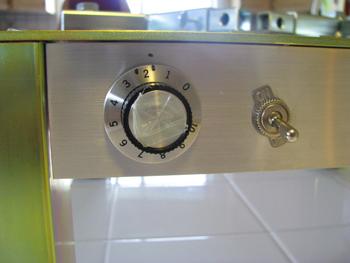
This was the only area where I found some issues with the annealer. As the picture shows, the dial is very sensitive, with a narrow operating range. Try and move a bit too fast and the rotating arm over cams the turntable and jams.
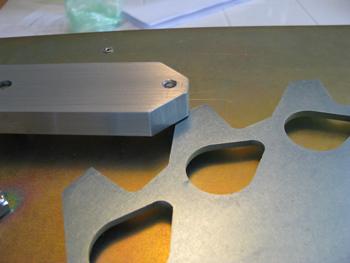
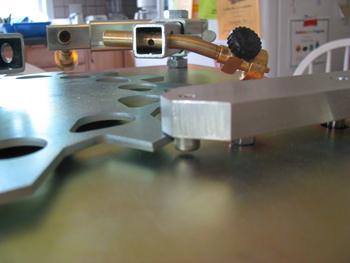
When you first plug it in, turn the dial to 1 and slowly advance. You will quickly see the range that it works and you can mark it on the dial as I have. Once that is figured out, there is no problem in actual use. The dial works well and stays set.
Keeping the case in the flame for the same amount of time is critical, and the M350 Annealer does a fantastic job. I timed 20 to 50 movements at various operating speeds while the annealer moved cases around, and the time was within the same tenth of a second. My error in timing is at least that much. This is as near perfect as you are going to get.
In general, the speed of the turntable is kept constant and the flame intensity is adjusted to get the right heat cycle. Either can be used to fine tune the process.
Using moderate flame heat, a 308 case will need 7-8 seconds of exposure - a 223 a few seconds less, a 338 Lapua mag a bit longer. The time is confirmed with test cases coated with the temp indicator. I have up to ten cases to help with the setup and reuse them every time the annealer is restarted.
The one thing that needs to be done before using the annealer each time is to warm up the electronics. I found that in the first couple of minutes, the timing was off and drifted, but once it settled down, it was dead steady. So turn on the annealer while you are getting your stuff organized and it will be ready to go when you are.
The M350 annealer is very well built and has some nice unique features that can make this step in case prep quick and easy to accomplish. Best part is knowing that the cases are annealed the same which can only improve your accuracy or at the very least, leave more green in your wallet.
How to Monitor the Case Neck Temperature
Monitoring the temperature is very easy these days. Welders have needed this type of temperature indicator for years and products have been developed for this that are not only easy to use, but inexpensive and reliably accurate.
The brand that is most commonly used is Tempilac, and they offer both a solid crayon as well as a paint. Both products work the same way by melting/vaporizing when the desired temperature has been reached. The product comes in 50F increments. The hottest brass should reach is 800F and going over this can turn the alloy into taffy. The lowest temperature that is reported to start the annealing process is 700F. I use 750F as a nice median.
Welding supply stores will be able to offer these or similar product. Just make sure that whatever you use doesn't leave a hard residue behind. This is no fun to remove later.
Jerry Teo shoots regularly out to one mile and also competes in F class. His current cartridges are 223, 6.5 Mystic, 7 Mystic, 308, 300RUM and 338 Mystic. He enjoys experimenting with gear and wildcatting in order to increase accuracy performance and to debunk accuracy myths.

